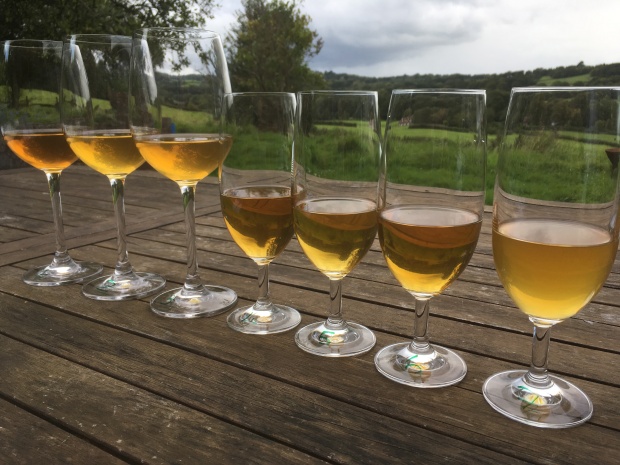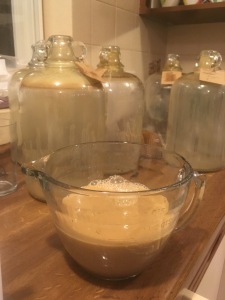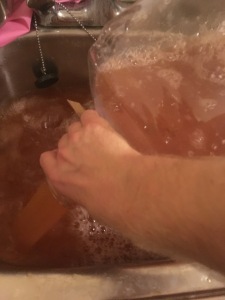It often feels like September can go two ways; an Indian summer or plunge straight into Autumn. This year the weather seems to be doing a bit of both, changing the mood, as it does. @circleofpines on Instagram quoted Tove Jansson from The Summer Book, better articulating this tipping point:
“It is still summer, but summer is no longer alive. It has come to a standstill; nothing withers, and fall is not ready to begin”.
A few flowers are still holding on: water mint, perennial sowthistle, common fleabane and heather are still providing colour. On the flip side there are now plenty of mushrooms and the apples are falling. I started collecting the apples this weekend. I love the peace of this annual ritual for me. There is always a stillness in the air after the buzz of summer, broken only by the occasional robin or blackbird pipping in the tree next to me. There is the smell of dampness, soil and decay in the air and I enjoy the meditative repetitive action: pick apple, inspect, wipe, bag, repeat. The apples will be juiced, I’ll make some cider and make some beer with the lees.
The family left me on my lonesome for the weekend, which gave me the space and time to blend and bottle a few of the single flower ferments from the spring and brew a batch for the yeast / trub left behind.
Before blending I took samples from the first seven demijohns, took gravity reading and pH readings before tasting. I tasted at room temperature and then again after they had been in the fridge. The findings were as follows:
| Originating Flower | Gravity | pH | Tasting Notes |
| Gorse | 1.010 | 4.6 | Clear. Golden. Aroma and taste of honey and slight petrol (like some rieslings). Sweeter than blackthorn. Not much acidic structure.
On second (chilled) tasting, marzipan/coconut-like gorse flowers. A slight astringency. |
| Primrose | 1.005 | 3.8 | Clear. Yellow gold. Flowery. Marzipan. Less zingy than Wild Apple.
Honey like. Less marzipan like. |
| Blackthorn | 1.005 | 4.8 | Clear. Yellow gold. Less distinct.
Most sloe gin-like marzipan character. |
| Dandelion | 1.003 | 4.5 | Clear. Golden. Really nice perfumed floral aroma. (this might be the higher hopping). Zingy hop bitterness. |
| Wild Apple | 1.003 | 4.2 | Clear. Golden. Slightly dirty on first tasting but this might have been in comparison to Dandelion. Pleasant fruity tang.
Fruitier than Garden Apple 2. |
| Garden Apple 1 | 1.002 | 4.6 | Clear. Golden. Zingy tang again. Fruity.
Not as sweet as Wild Apple. |
| Garden Apple 2 | 1.006 | 4.0 | Slightly cloudy. Sweeter than Garden Apple 1.
Bitterness. Less aroma than first three. |

Overall I was pleased they were drinkable and slightly surprised by the lack of variation. That said there were only three base brews for the seven samples and the recipes were similar. The Nelson Sauvin was the most distinct because of the relatively high rate of hopping. The level of hop bitterness in all three batches had likely inhibited lactic acid production and in future I need to be bolder and braver and reduce the hop level below 10 IBU. I knew it was too high but I wanted to replicate saison recipes that had previously been successful. The multiple sensory tests before the main brew probably also account for the lack of off flavours and funkiness. They are also still fairly young. More savoury brett character might develop over the next six months. There are also another eight single flower based ferments to blend over the coming months.
Following the tasting I decided to leave Garden Apple 2 to further clear and develop over time and to blend equal measures of the other six to combine the floral/marzipan aromas with the fruity zingy hop character, making 21 litres. That left two 375ml bottles of each unblended for comparison and yeast storage and 1000ml of yeast slurry / trub for the next brew. I used 400ml of this slurry in 10l.

1 litre of yeast slurry and trub from the first six demijohns
Next year I need to try and focus on a lactic acid culture in some of my wild capture starters. I will read up about it but I will probably minimise hop bitterness, exclude oxygen and keep the temperature around 40 deg C.
Standing forgotten on a shelf were four 250ml conical flasks from at least a month ago. Musk mallow had developed a thick gelatinous cap and fluffy mould so was binned. Blackberry 1 was cloudy and had an aroma of spicy fruit. The gravity was 1030 and the pH was 4.8. Blackberry 2 was clear with a thick gelatinous cap. Initially it smelt slightly cheesy but this passed. The gravity was also 1030 and the pH was 4.5. As little alcohol or acidity had been produced I decided to bin both. That left the final flask. The meadowsweet was clear and had the aroma of nectarines. The Gravity was 1008 and the pH was 3.6. The taste was tart, astringent and fruity – definitely a keeper.
For my next brew I decided to take elements of the grain bill from the 8-wired Nelson Sauvin recipe used in batch 3 and the European hops from the Burning Sky recipe used in batch 5, making a few changes to use up the grain I had available. My intention was to use 10 litres for the blended yeast slurry from the first six captures and 5 litres for the meadowsweet yeast capture and, for the final 5 litres, I collected a couple of large handfuls of flowering heather and put them straight in a demijohn. I thought it would be interesting to skip the propagation steps, increase the quantity of flowers, hopefully adding flavour as well as yeast and bacteria. The base recipe was as follows:
OG:1.056 FG:1.009 ABV:6.0% SRM:6 IBU:17 20L batch
53% Maris Otter malt
24% Pilsner malt
11% wheat malt
2% spelt malt
4% flaked wheat
4% caragold
2% acidulated malt
18g East Kent Golding (5.92% AA) at 60mins
18g East Kent Golding at 15mins
15g each of Saaz, Celeia and East Kent Golding at 0mins
I mashed at 65 deg C for an hour then sparged to 22 litres when the gravity was 1.010. 7 litres evaporated or were absorbed by the hops during the boil and, in a rush, I liquored back to 20 litres without taking gravity readings. When I then checked it was 1.048, so the ABV will be 5.1%, but I’m not going to loose sleep over it. I should have sparged a few more litres before the gravity fell below 1.010. Looking back over my brewing calculator the efficiency was set higher than I would normally set it, so that’s probably why. There was a couple of hours pause between chilling and racking to fermentors. While I would have preferred to avoid this it did allow the cold break to settle really well, allowing clear wort to be siphoned off.
So what next? I don’t intend to collect anymore flowers this year. I will continue to blend the beer I have when it is ready, bottle it, propagate the yeast and and report back on that process and the results. If the beers from the blended yeast is successful I will get a barrel and start ageing them – fingers crossed. Over the autumn and winter I would like to give a bit of time to pale ales, bitters, porters and maybe a stronger stock ale and will report back if I think they’re relevant to the blog. Looking ahead I have had some thoughts for next year but I think I will leave that for another blog post in a few months time.
And finally, proof that not every brew is a success. The braggot with saison yeast, strawberries and grains of paradise from a few months ago was a “Braison” failure. 5g of grains of paradise were added rather than 0.5g. I hope it might improve but it reached tipping point…











